Whether it be for lack of budget or a desire to take center stage, series creators lending their own voices to their animated television shows has always been fairly commonplace – Mike Judge (Beavis and Butthead, King of the Hill), John Kricfalusi (Ren and Stimpy), Seth MacFarlane (Family Guy) and Trey Parker and Matt Stone (South Park) immediately spring to mind. However, in recent years, more and more feature directors have started getting in on the trend. From throwaway one-liners to continuous roles throughout entire franchises, here is a list of some animation directors and the characters they brought to life in their own films.
1. Eric Goldberg
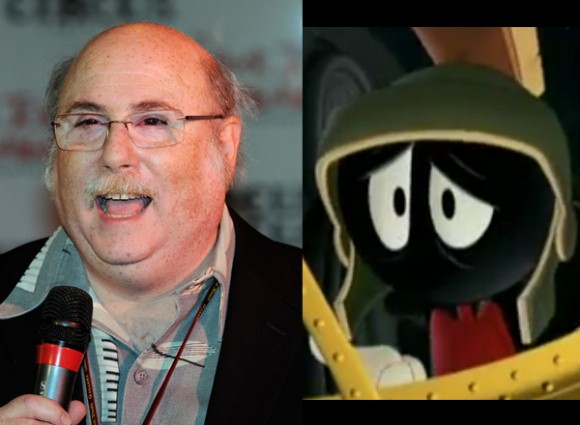 As the animation director for Looney Tunes: Back in Action (2003), Goldberg not only supervised the animation of the WB’s classic characters but he voiced some of them as well. Goldberg recorded the dialogue of Marvin the Martian, Tweety Bird and Speedy Gonzalez.
As the animation director for Looney Tunes: Back in Action (2003), Goldberg not only supervised the animation of the WB’s classic characters but he voiced some of them as well. Goldberg recorded the dialogue of Marvin the Martian, Tweety Bird and Speedy Gonzalez.
2. Pierre Coffin and Chris Renaud
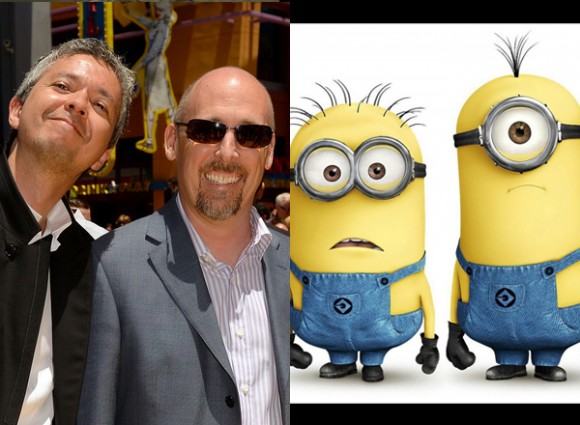 The distinctive sputters, spurts and high-speed mutterings of The Minions in Despicable Me (2010) and Despicable Me 2 (2013) belong to the films’ co-directors Pierre Coffin (above left) and Chris Renaud. And as the character’s popularity grows, so does their vocal commitment, as the two will reprise their roles in next year’s prequel Minions.
The distinctive sputters, spurts and high-speed mutterings of The Minions in Despicable Me (2010) and Despicable Me 2 (2013) belong to the films’ co-directors Pierre Coffin (above left) and Chris Renaud. And as the character’s popularity grows, so does their vocal commitment, as the two will reprise their roles in next year’s prequel Minions.
3. Ralph Bakshi
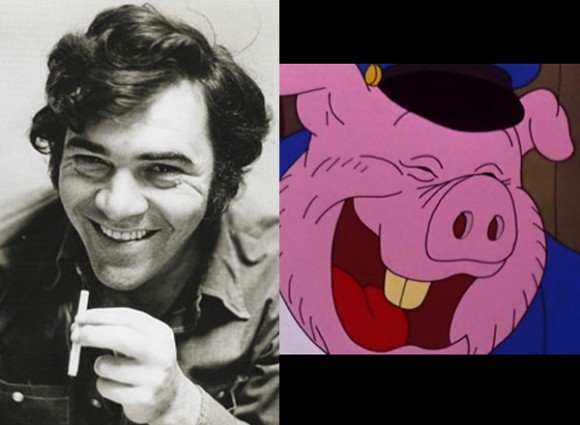 In his debut film Fritz the Cat (1972), director Ralph Bakshi voiced one of the boorish antagonist Pig Cops, who is also referred to as “Ralph” multiple times in his scenes.
In his debut film Fritz the Cat (1972), director Ralph Bakshi voiced one of the boorish antagonist Pig Cops, who is also referred to as “Ralph” multiple times in his scenes.
4. Brad Bird
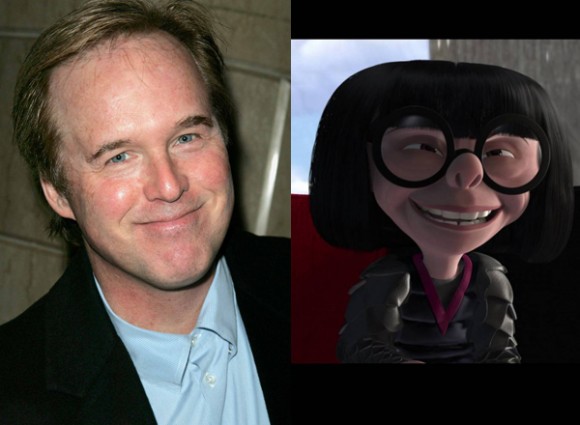 Agnes Gooch, Edith Head, Patricia Highsmith, Linda Hunt – when it comes to figuring out who inspired the character of Edna Mode, people love to toss out many names, but in the end, the cutthroat designer of superhero fashion was brought to life by The Incredibles (2004) director Brad Bird.
Agnes Gooch, Edith Head, Patricia Highsmith, Linda Hunt – when it comes to figuring out who inspired the character of Edna Mode, people love to toss out many names, but in the end, the cutthroat designer of superhero fashion was brought to life by The Incredibles (2004) director Brad Bird.
5. Rich Moore
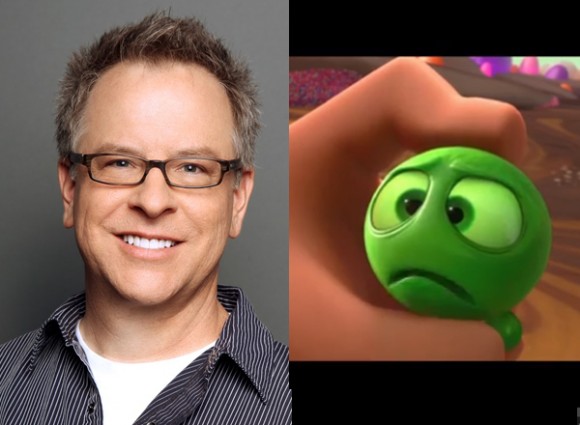 Rich Moore, director of Wreck-It Ralph (2012) provided the dreary monotone of acidic jawbreaker Sour Bill, the henchman to the bombastic King Candy.
Rich Moore, director of Wreck-It Ralph (2012) provided the dreary monotone of acidic jawbreaker Sour Bill, the henchman to the bombastic King Candy.
6. Richard Williams
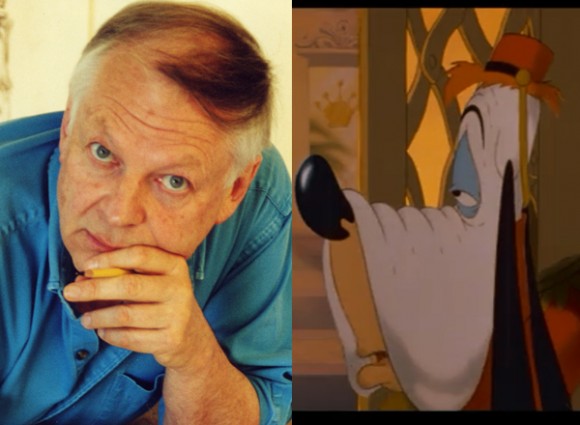 Even to this day, the toon celebrity cameos in Who Framed Roger Rabbit(1988) remain some of the best nods to the golden age of cartoons, especially that of Droopy Dog, who gets his opportunity to best Eddie Valiant with some traditional ‘toon high-jinks as a tricky elevator operator, sluggishly voiced by the film’s animation director Richard Williams.
Even to this day, the toon celebrity cameos in Who Framed Roger Rabbit(1988) remain some of the best nods to the golden age of cartoons, especially that of Droopy Dog, who gets his opportunity to best Eddie Valiant with some traditional ‘toon high-jinks as a tricky elevator operator, sluggishly voiced by the film’s animation director Richard Williams.
7. Chris Wedge
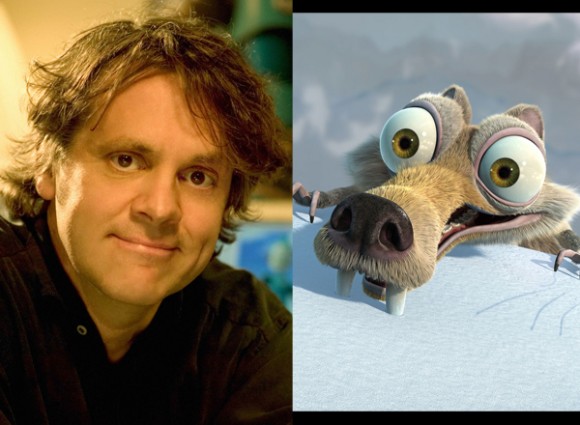 What began as the high-strung snivels and snarls of Scrat in Ice Age (2002) has become a second career for director Chris Wedge who has gone on to vocally personify the prehistoric rodent in 3 sequels, 6 short films, 2 video games and in a walk-on role in an episode of Family Guy.
What began as the high-strung snivels and snarls of Scrat in Ice Age (2002) has become a second career for director Chris Wedge who has gone on to vocally personify the prehistoric rodent in 3 sequels, 6 short films, 2 video games and in a walk-on role in an episode of Family Guy.
8. Chris Miller
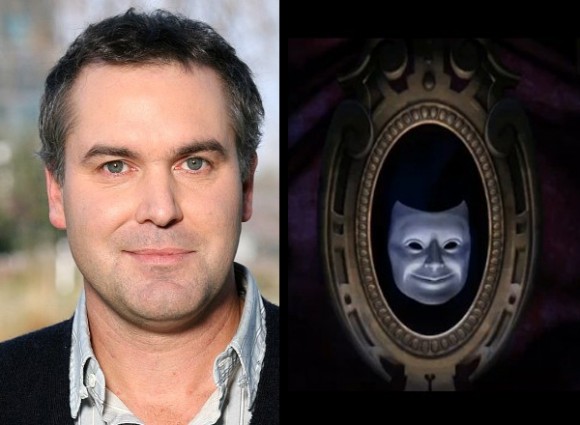 Royal messengers, tower guards, army commanders, friars and penguins, story artist Chris Miller has lent his voice-over skills to numerous animated films, most notably his returning roles as Geppetto and The Magic Mirror in the Shrek franchise, including Shrek the Third (2007), which he co-directed.
Royal messengers, tower guards, army commanders, friars and penguins, story artist Chris Miller has lent his voice-over skills to numerous animated films, most notably his returning roles as Geppetto and The Magic Mirror in the Shrek franchise, including Shrek the Third (2007), which he co-directed.
9. Mark Dindal
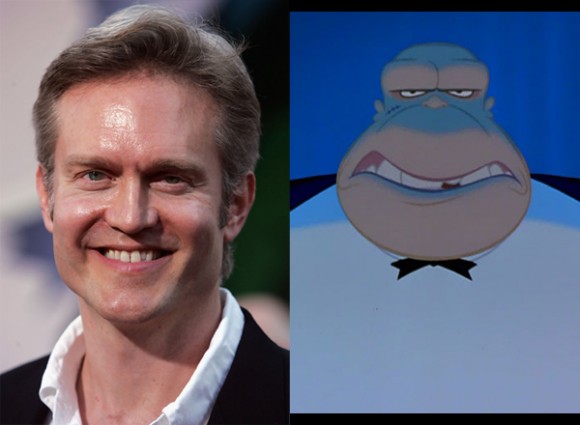 The often ignored and underrated animated film Cats Don’t Dance (1997) features some beautiful hand-drawn work and stellar vocal performances, including that of director Mark Dindal as the tight-lipped bodyguard/butler Max.
The often ignored and underrated animated film Cats Don’t Dance (1997) features some beautiful hand-drawn work and stellar vocal performances, including that of director Mark Dindal as the tight-lipped bodyguard/butler Max.
10. Joe Ranft
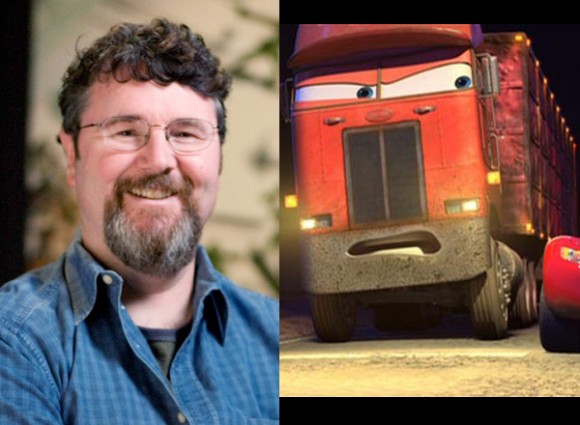 Pixar story artist, the late Joe Ranft, brought a handful of memorable animated characters to life, including Heimlich (A Bug’s Life), Wheezy the Penguin (Toy Story 2) and Jacques the Cleaner Shrimp (Finding Nemo). But it was in Cars (2006), which he co-directed, that he voiced three characters including the semi-truck Jerry Recycled Batteries.
Pixar story artist, the late Joe Ranft, brought a handful of memorable animated characters to life, including Heimlich (A Bug’s Life), Wheezy the Penguin (Toy Story 2) and Jacques the Cleaner Shrimp (Finding Nemo). But it was in Cars (2006), which he co-directed, that he voiced three characters including the semi-truck Jerry Recycled Batteries.
11. Chris Sanders
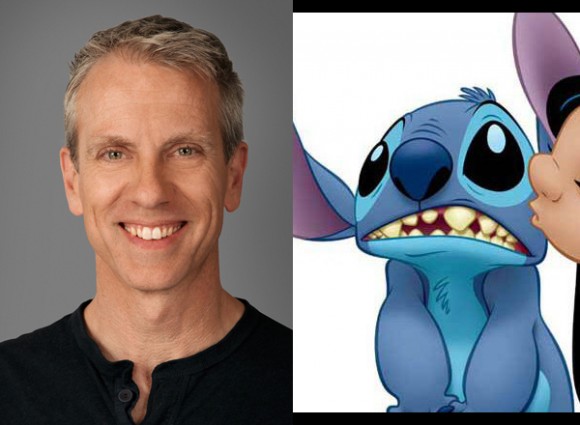 In Lilo & Stitch (2002) co-director Chris Sanders takes on the nuanced role of Alien Experiment 626, aka “Stitch,” who escapes from an intergalactic prison only to find himself trapped on the Hawaiian island of Kauai.
In Lilo & Stitch (2002) co-director Chris Sanders takes on the nuanced role of Alien Experiment 626, aka “Stitch,” who escapes from an intergalactic prison only to find himself trapped on the Hawaiian island of Kauai.
12. Nathan Greno and Byron Howard
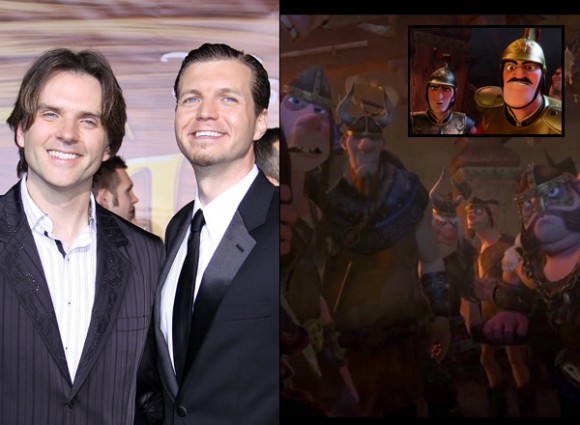 Nathan Greno (above right) and Byron Howard not only paired up as co-directors of Tangled (2010) but also doubled as duos of Thugs and Guards in the animated picture.
Nathan Greno (above right) and Byron Howard not only paired up as co-directors of Tangled (2010) but also doubled as duos of Thugs and Guards in the animated picture.
13. John Lasseter
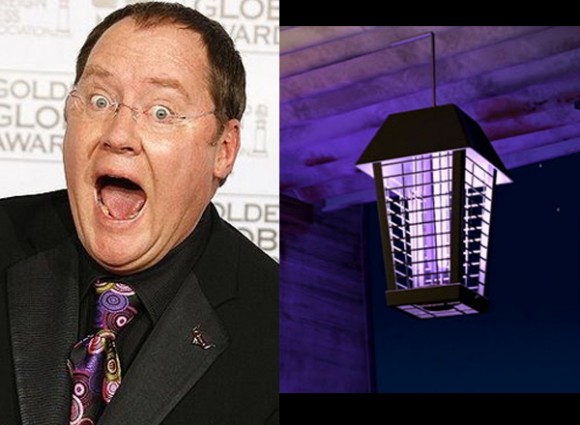 With five features under his belt, John Lasseter has had plenty of opportunity to throw himself behind the microphone, however upon review of his filmography, you’ll find he has chosen his roles very carefully, as the role of John Lassetire in Cars 2 (2011) and the hilariously bug-zapped Harry the Mosquito in A Bug’s Life (1998).
With five features under his belt, John Lasseter has had plenty of opportunity to throw himself behind the microphone, however upon review of his filmography, you’ll find he has chosen his roles very carefully, as the role of John Lassetire in Cars 2 (2011) and the hilariously bug-zapped Harry the Mosquito in A Bug’s Life (1998).

The intersection between animation and fashion isn’t always well defined, but it is expanding. In the latest issue of Galore, Jerome LaMaar (aka Style Monk) illustrated a two-page spread of Jessica Rabbit wearing lingerie from the recent collections of houses like Atelier Versace, Agent Provocateur, La Perla, Christian Louboutin, Azzedine Alaia and Dolce & Gabbana. It’s a curious blending of real and imagined worlds that shows the potential for future collaborations between fashion and animation, like perhaps, a fashion designer designing the clothes for the characters in a CG animated feature.
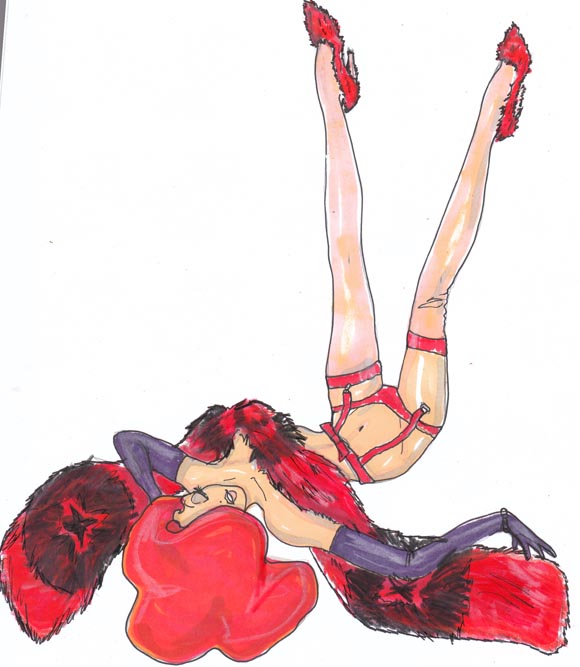
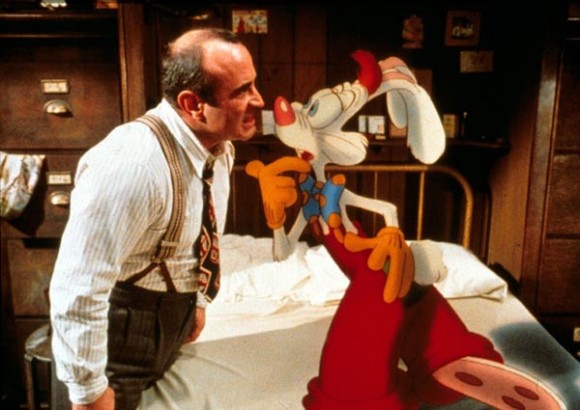
ROSS ANDERSON is currently writing the definitive book about the making of Roger Rabbit, beginning with Gary K. Wolf’s novel and Disney’s early Roger Rabbit development unit, continuing with the production of “Who framed Roger Rabbit”, and through the follow-up shorts, merchandising and theme park presence, and development work on sequels. He wrote this piece exclusively for Cartoon Brew about the 25th anniversary screening of “Roger Rabbit” that took place last week in Los Angeles.
On Thursday evening, April 4th, the Academy of Motion Picture Arts and Sciences hosted the first public screening of the new digital print of Who framed Roger Rabbit. The preparation of the digital print coincides with the release of the 25th anniversary Blu-ray edition of the film , and the Academy hosted a terrific show.
, and the Academy hosted a terrific show.
When the tickets were made available on-line they sold out within a day or two. The film was enormously popular when it was released and it has been a touchstone for film and animation enthusiasts ever since. I can’t take credit for the touchstone/Touchstone remark—that came from Rich Moore, director of Wreck-It Ralph, who was the moderator of the panel discussion that followed the film screening.
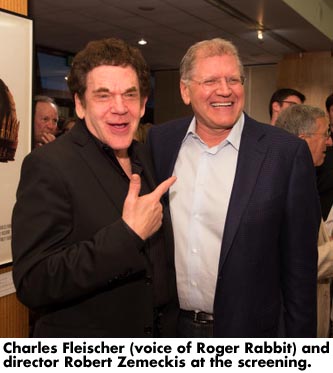 The event attendees were polite and mature in their behavior, although many of them hadn’t been born when the film was released. The enthusiasm for the film has some of the earmarks of coltishness, but it is not as though the adoration is a personal ‘find’ and a delight against all reason. There are ample reasons to delight in the film, and everybody has their own joys that they find in it. Mine – is that I had been a life-long animation enthusiast who found it difficult to share my enthusiasm with friends. I was in university when Robin Hood was released. I would have been harassed unmercifully if my interest in Disney animation had become known to my dorm-mates. Who framed Roger Rabbit made animation ‘cool’ again…and it made money, which increased the enthusiasm of the studios. Many people in the animation industry credit the film with ushering in a silver age of feature animation.
The event attendees were polite and mature in their behavior, although many of them hadn’t been born when the film was released. The enthusiasm for the film has some of the earmarks of coltishness, but it is not as though the adoration is a personal ‘find’ and a delight against all reason. There are ample reasons to delight in the film, and everybody has their own joys that they find in it. Mine – is that I had been a life-long animation enthusiast who found it difficult to share my enthusiasm with friends. I was in university when Robin Hood was released. I would have been harassed unmercifully if my interest in Disney animation had become known to my dorm-mates. Who framed Roger Rabbit made animation ‘cool’ again…and it made money, which increased the enthusiasm of the studios. Many people in the animation industry credit the film with ushering in a silver age of feature animation.
Academy member and veteran animation director Bill Kroyer introduced the screening. Bill was a young animator at the Disney studio prior to the first onslaught of CalArts grads, who included John Lasseter, Tim Burton, Brad Bird, Henry Selick, John Musker, Jerry Rees, and Darrell Van Citters. They were all frustrated with how Disney animation was functioning in the early-1980s.
Tom Wilhite, the young Disney Live-Action Studio Head, saw their frustration and did what he could to enable projects that would satisfy their creative juices and keep them at the studio. Aside from John Musker, they were all eventually fired or left the studio of their own accord, but out of that early grouping came Tim Burton’s Vincent and Frankenweenie and John Lasseter’s The Brave Little Toaster, which Wilhite eventually produced, with Jerry Rees directing, as ‘Hyperion Pictures’, after he, too, left Disney. Wilhite also brought Tron to the Disney studio and was responsible for setting up the Roger Rabbit development unit at Disney in 1981, helmed by Darrell Van Citters.
Bill Kroyer was one of the first ‘animators’ to do computer animation. He and Jerry Rees were assigned to the Tron production to work with the early CGI providers. The computer software at that time was not intuitive at all, so there was more hand-drawn ‘logistical guidance’ for the programmers than most people realize. That was Bill and Jerry. Their involvement also fired up John Lasseter’s interest in computer animation. The Brave Little Toaster was intended to be the first full length CGI animated feature.
Tom Wilhite sent memos to scoop up Bill Kroyer, Jerry Rees, John Lasseter, Ron Clements, Mike Gabriel, Randy Cartwright, and Glen Keane for the Roger Rabbit unit… Wouldn’t that have been something?
Tron was released in 1982, at a time that the Darrell Van Citters’ Roger Rabbit development unit was getting into full swing. Screenwriters Peter Seaman and Jeffrey Price had just come off of Trenchcoat, a Disney mystery/comedy, and Wilhite assigned them to prepare a screenplay for Roger Rabbit. At that time Wilhite also sent memos to Darrell and Marc Stirdivant, the Disney house producer assigned to the development unit, to scoop up Bill Kroyer, Jerry Rees, John Lasseter, Ron Clements, Randy Cartwright, Mike Gabriel, and Glen Keane for the Roger Rabbit unit. Other things were happening at the studio, and soon most of those people were gone… but wouldn’t that have been something?
Back to the screening – Bill Kroyer called out many of the attendees who had been instrumental in making the film. This list isn’t exhaustive, but those who did stand up included voice actors Charles Fleischer (Roger Rabbit, Benny the Cab and others), June Foray (Lena Hyena), and Tony Anselmo (Donald Duck), animators Andreas Dejas and Nik Ranieri, screenwriters Seaman and Price, editor Artie Schmidt, London studio manager Max Howard, producers Steve Starkey and Don Hahn, and, of course, director Bob Zemeckis.
The film screening was wonderful. The digital print was clear and fresh and the colors popped out at you. Not having seen the film on the big screen for twenty-five years, I found it difficult to discern whether the viewing pleasure was due to anything particular associated with the digital print or simply that I was sharing the big screen experience with a room full of similarly enthusiastic viewers. The quality aspects of the digital restoration were being hotly debated within knots of people after the screening was over.
A panel discussion followed the screening. It was hosted by Rich Moore and included Peter Seaman, Jeffrey Price, Andreas Deja, Charles Fleischer, Joanna Cassidy, Steve Starkey, Bob Zemeckis, and Don Hahn. There were many reminiscences from the production. Most of them were well known to the real Roger Rabbit enthusiasts, but the ones who resonated the most for me were those that put the ‘25-years’ into perspective. We have heard about Who framed Roger Rabbit having way more special effects than Star Wars, but it was also one of the last of the great ‘optical’ effects films. It was a different era.
Zemeckis reminisced that, “we had FedEx and ¾” tape – we had technology by the tail.” He spoke about the first finished animation that came over from the London studio unit. It was the portion of the introductory Something Cookin’ cartoon in which the chili sauce falls off the shelf in Roger’s kettle-head. The British animators spelled ‘chili’ in the British manner, with two l’s (‘chilli’). The scene had to be completely re-animated.
In the scene which the camera trucks over the newspaper headlines showing the Toon cases solved by Valiant & Valiant on Eddie’s desk, the London studio had used the banners of LA newspapers of the time (1947), without having asked permission of the newspapers. One newspaper ended up refusing permission to use their banner – and this complicated scene had to be completely re-shot. Another anecdote was that Paul Newman had been considered for the role of Eddie Valiant. Charles Fleischer immediately shot back that Judge Doom would then have had to use ‘dressing’ instead of ‘dip’.
The greatest benefit of the digital presentation was the close-ups on the actors’ faces…there was sublime acting and emotion that contributed enormously to the ‘reality’ of their interaction with the ’toons.
Don Hahn made a call out for Richard Williams, who recently celebrated his 80th birthday. Richard had hoped to attend but was unable to make it. Also, during the panel discussion, it became clear that the presence of Bob Hoskins was greatly missed. He was universally acclaimed for his work on the film. I must say that the greatest benefit that I saw with the digital presentation was in the close-ups on the actors’ faces. There was sublime acting and emotion that contributed enormously to the ‘reality’ of their interaction with the ’toons. We ‘felt’ it and it was an integral aspect of the great ‘conceit’ of the live-action/toon combination, but the subliminal effects were often lost in the chaos of the action. In this viewing, they popped out at me.

It was a great night. Following the conclusion of the panel discussionm, the many Roger Rabbit production participants reunited on stage to catch up on 25 years. The ‘celebrities’ amongst them were cornered for autographs, and the ‘no photography’ policy of the Academy theater was completely thrown out the window as the hundreds of cameras that were spirited into the theater finally came out.
A group shot was hastily organized and there were many more Roger Rabbit alumni present than had been called out during the evening’s introduction. I counted at least twenty-five alumni. I had the pleasure of speaking to many of them and seeing several of them the next day. It was a special night for Roger Rabbit fans and a special night for those who were involved in making it.
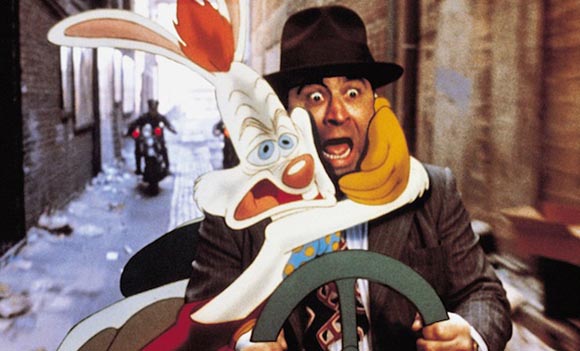
To celebrate the upcoming 80th birthday of Richard Williams, 92Y Tribeca will present three evenings of screenings devoted to his work:
Wednesday, February 27: A screening of Who Framed Roger Rabbit on 35mm. (It is the film’s 25th anniversary this year.)
Thursday, February 28: An evening of Richard Williams rarities including his ambitious early short The Little Island (1958). The program will be introduced by NY animation director (and former Williams employee) Michael Sporn.
Friday, March 1: A screening of the fantastic new documentary Persistence of Vision, about Williams’ decades-long attempt to create his personal masterpiece The Thief and the Cobbler. I’ll be hosting a discussion with the director of the documentary, Kevin Schreck, after the 7pm screening.
92Y Tribeca is located in Manhattan (200 Hudson Street, NY, NY 10013). Tickets for each screening are $12 and available on the 92Y Tribeca website.



 As the animation director for Looney Tunes: Back in Action (2003), Goldberg not only supervised the animation of the WB’s classic characters but he voiced some of them as well. Goldberg recorded the dialogue of Marvin the Martian, Tweety Bird and Speedy Gonzalez.
As the animation director for Looney Tunes: Back in Action (2003), Goldberg not only supervised the animation of the WB’s classic characters but he voiced some of them as well. Goldberg recorded the dialogue of Marvin the Martian, Tweety Bird and Speedy Gonzalez. The distinctive sputters, spurts and high-speed mutterings of The Minions in Despicable Me (2010) and Despicable Me 2 (2013) belong to the films’ co-directors Pierre Coffin (above left) and Chris Renaud. And as the character’s popularity grows, so does their vocal commitment, as the two will reprise their roles in next year’s prequel Minions.
The distinctive sputters, spurts and high-speed mutterings of The Minions in Despicable Me (2010) and Despicable Me 2 (2013) belong to the films’ co-directors Pierre Coffin (above left) and Chris Renaud. And as the character’s popularity grows, so does their vocal commitment, as the two will reprise their roles in next year’s prequel Minions. In his debut film Fritz the Cat (1972), director Ralph Bakshi voiced one of the boorish antagonist Pig Cops, who is also referred to as “Ralph” multiple times in his scenes.
In his debut film Fritz the Cat (1972), director Ralph Bakshi voiced one of the boorish antagonist Pig Cops, who is also referred to as “Ralph” multiple times in his scenes. Agnes Gooch, Edith Head, Patricia Highsmith, Linda Hunt – when it comes to figuring out who inspired the character of Edna Mode, people love to toss out many names, but in the end, the cutthroat designer of superhero fashion was brought to life by The Incredibles (2004) director Brad Bird.
Agnes Gooch, Edith Head, Patricia Highsmith, Linda Hunt – when it comes to figuring out who inspired the character of Edna Mode, people love to toss out many names, but in the end, the cutthroat designer of superhero fashion was brought to life by The Incredibles (2004) director Brad Bird. Rich Moore, director of Wreck-It Ralph (2012) provided the dreary monotone of acidic jawbreaker Sour Bill, the henchman to the bombastic King Candy.
Rich Moore, director of Wreck-It Ralph (2012) provided the dreary monotone of acidic jawbreaker Sour Bill, the henchman to the bombastic King Candy. Even to this day, the toon celebrity cameos in Who Framed Roger Rabbit(1988) remain some of the best nods to the golden age of cartoons, especially that of Droopy Dog, who gets his opportunity to best Eddie Valiant with some traditional ‘toon high-jinks as a tricky elevator operator, sluggishly voiced by the film’s animation director Richard Williams.
Even to this day, the toon celebrity cameos in Who Framed Roger Rabbit(1988) remain some of the best nods to the golden age of cartoons, especially that of Droopy Dog, who gets his opportunity to best Eddie Valiant with some traditional ‘toon high-jinks as a tricky elevator operator, sluggishly voiced by the film’s animation director Richard Williams. What began as the high-strung snivels and snarls of Scrat in Ice Age (2002) has become a second career for director Chris Wedge who has gone on to vocally personify the prehistoric rodent in 3 sequels, 6 short films, 2 video games and in a walk-on role in an episode of Family Guy.
What began as the high-strung snivels and snarls of Scrat in Ice Age (2002) has become a second career for director Chris Wedge who has gone on to vocally personify the prehistoric rodent in 3 sequels, 6 short films, 2 video games and in a walk-on role in an episode of Family Guy. Royal messengers, tower guards, army commanders, friars and penguins, story artist Chris Miller has lent his voice-over skills to numerous animated films, most notably his returning roles as Geppetto and The Magic Mirror in the Shrek franchise, including Shrek the Third (2007), which he co-directed.
Royal messengers, tower guards, army commanders, friars and penguins, story artist Chris Miller has lent his voice-over skills to numerous animated films, most notably his returning roles as Geppetto and The Magic Mirror in the Shrek franchise, including Shrek the Third (2007), which he co-directed. The often ignored and underrated animated film Cats Don’t Dance (1997) features some beautiful hand-drawn work and stellar vocal performances, including that of director Mark Dindal as the tight-lipped bodyguard/butler Max.
The often ignored and underrated animated film Cats Don’t Dance (1997) features some beautiful hand-drawn work and stellar vocal performances, including that of director Mark Dindal as the tight-lipped bodyguard/butler Max. Pixar story artist, the late Joe Ranft, brought a handful of memorable animated characters to life, including Heimlich (A Bug’s Life), Wheezy the Penguin (Toy Story 2) and Jacques the Cleaner Shrimp (Finding Nemo). But it was in Cars (2006), which he co-directed, that he voiced three characters including the semi-truck Jerry Recycled Batteries.
Pixar story artist, the late Joe Ranft, brought a handful of memorable animated characters to life, including Heimlich (A Bug’s Life), Wheezy the Penguin (Toy Story 2) and Jacques the Cleaner Shrimp (Finding Nemo). But it was in Cars (2006), which he co-directed, that he voiced three characters including the semi-truck Jerry Recycled Batteries. In Lilo & Stitch (2002) co-director Chris Sanders takes on the nuanced role of Alien Experiment 626, aka “Stitch,” who escapes from an intergalactic prison only to find himself trapped on the Hawaiian island of Kauai.
In Lilo & Stitch (2002) co-director Chris Sanders takes on the nuanced role of Alien Experiment 626, aka “Stitch,” who escapes from an intergalactic prison only to find himself trapped on the Hawaiian island of Kauai. Nathan Greno (above right) and Byron Howard not only paired up as co-directors of Tangled (2010) but also doubled as duos of Thugs and Guards in the animated picture.
Nathan Greno (above right) and Byron Howard not only paired up as co-directors of Tangled (2010) but also doubled as duos of Thugs and Guards in the animated picture. With five features under his belt, John Lasseter has had plenty of opportunity to throw himself behind the microphone, however upon review of his filmography, you’ll find he has chosen his roles very carefully, as the role of John Lassetire in Cars 2 (2011) and the hilariously bug-zapped Harry the Mosquito in A Bug’s Life (1998).
With five features under his belt, John Lasseter has had plenty of opportunity to throw himself behind the microphone, however upon review of his filmography, you’ll find he has chosen his roles very carefully, as the role of John Lassetire in Cars 2 (2011) and the hilariously bug-zapped Harry the Mosquito in A Bug’s Life (1998).


 The event attendees were polite and mature in their behavior, although many of them hadn’t been born when the film was released. The enthusiasm for the film has some of the earmarks of coltishness, but it is not as though the adoration is a personal ‘find’ and a delight against all reason. There are ample reasons to delight in the film, and everybody has their own joys that they find in it. Mine – is that I had been a life-long animation enthusiast who found it difficult to share my enthusiasm with friends. I was in university when Robin Hood was released. I would have been harassed unmercifully if my interest in Disney animation had become known to my dorm-mates. Who framed Roger Rabbit made animation ‘cool’ again…and it made money, which increased the enthusiasm of the studios. Many people in the animation industry credit the film with ushering in a silver age of feature animation.
The event attendees were polite and mature in their behavior, although many of them hadn’t been born when the film was released. The enthusiasm for the film has some of the earmarks of coltishness, but it is not as though the adoration is a personal ‘find’ and a delight against all reason. There are ample reasons to delight in the film, and everybody has their own joys that they find in it. Mine – is that I had been a life-long animation enthusiast who found it difficult to share my enthusiasm with friends. I was in university when Robin Hood was released. I would have been harassed unmercifully if my interest in Disney animation had become known to my dorm-mates. Who framed Roger Rabbit made animation ‘cool’ again…and it made money, which increased the enthusiasm of the studios. Many people in the animation industry credit the film with ushering in a silver age of feature animation.
